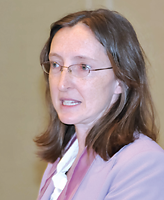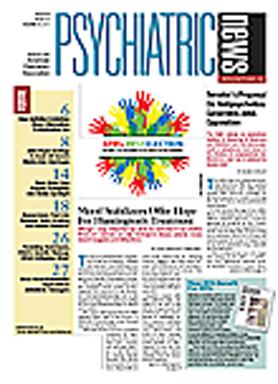More than 1.7 million episodes of agitation occur annually in U.S. emergency departments and are a leading cause of patient suffering and staff injuries.
Avoiding harm to all parties requires a complex juggling act on the part of psychiatrists and others, Garland Holloman, M.D., director of Psychiatric Emergency Services at the University of Mississippi Medical Center in Jackson, told an audience at APA’s Institute on Psychiatric Services in San Francisco in October.
“Emergency department staff need to use techniques of verbal deescalation while simultaneously managing physical medical diagnosis and treatment,” said Holloman. “The goal is to help the patient regain control.”
Holloman led a 30-person panel of the American Association for Emergency Psychiatry in developing new guidelines called “Best Practices in Evaluation and Treatment of Agitation.” The full guidelines will appear in the February 2012 issue of the Western Journal of Emergency Medicine.
Existing guidelines focus mainly on pharmacological strategies or seclusion and restraint to deal with agitated patients, he said. But there are better alternatives.
“Verbal deescalation takes less time than seclusion and restraint,” said Holloman. The latter usually means calling in a team, taking down the patient, putting the patient in restraints, risking injury, doing paperwork, and monitoring the patient afterward.
Using less-physical means to regain control will increase patient trust and cooperation both in the emergency room and afterward, as treatment continues, he said.
Agitation is an acute behavior emergency requiring an immediate intervention, said panelist Kimberly Nordstrom, M.D., J.D., an emergency psychiatrist at the Denver Health Medical Center. The first thing to do is to exclude life-threatening conditions.
“Agitation should be considered medical unless determined otherwise,” said Lindstrom. “The one exception is an agitated person with a known psychiatric dis order,” even when they have other nonpsychiatric medical disorders.
Triage begins with initial contact at a community mental health center, medical office, emergency department, or private psychiatric office, she said. The staff at the front desk should be trained to recognize the signs of agitation so that clinicians can begin the process of deescalation and diagnosis as soon as possible.
Obtain a brief history, either from the patient, charts, the front desk, bystanders, family, emergency medical technicians, or police, she said. Take vital signs and blood-sugar and oxygenation levels.
Severe headache, muscle stiffness, heat intolerance, new-onset psychosis, seizures, head trauma, or focal neural signs require immediate medical attention in an emergency department, she emphasized.
“If the patient can be deescalated, and agitation is a common symptom of a psychiatric illness, then routine management is appropriate.”
Relegate Drugs to Second-Line Treatment
Emergency room physicians have traditionally relied on drugs to sedate agitated patients. The new guidelines take a more circumspect view.
“Medications are the second line for treatment,” said David Pepper, M.D., acting director of emergency psychiatric services at Hartford Hospital in Connecticut. Pepper spoke on behalf of the guidelines panel’s medications-group chair, David Feifel, M.D., Ph.D., a professor of psychiatry at the University of California, San Diego, who was unable to attend the meeting.
“Use medications only when verbal techniques fail, but use them judiciously, for calming, not sedation,” said Pepper. “We can’t evaluate patients physically or psychiatrically when they’re asleep and we can’t discharge them either. So we want to calm them so they can participate in their care.”
Emergency psychiatrists have several choices of drugs for agitated patients, said Pepper. “But don’t reach for the IM Haldol right away.”
Three Drug Types Discussed
He discussed three groups of medications. First-generation antipsychotics have been around for awhile and have proven efficacy, he said. They are dopamine-2 receptor antagonists, have little effect on vital signs, and minimal drug/drug interactions.
Second-generation antipsychotics work at the D2 receptors and are also 5HTTA agonists. They, too, have good efficacy and come in different forms: tablets, IM, soluble tabs, and oral solutions that can give patients a choice.
Benzodiazepines work indirectly on GABA receptors and are preferred for use in cases of stimulant intoxication and alcohol withdrawal. They are also safer than antipsychotics for cases of “unknown” cause.
“But these drugs are not a cure,” said Pepper. “We still have to find out what the underlying cause of the agitation is.”
In the clinic, oral medications should be offered first, although some patients ask for an injection, he said. “It should be the patient’s choice.”
The sickest patients may still need seclusion or restraint when verbal interventions are insufficient, but psychiatrists should not stop deescalation techniques even then, said Holloman. Continuing to work with the patient may gain his or her cooperation and participation in treatment decisions, including decisions about how to get out of seclusion or restraint as soon as possible, he said.
The new guidelines can be used to develop policies in every emergency department, said Holloman.
“We can teach these techniques, but we have to practice them as well,” he said.
Ultimately, he said, the goals when caring for agitated patients are to exclude medical causes of symptoms, rapidly stabilize the acute crisis, avoid coercion, treat in the least-restrictive setting, form a therapeutic alliance with the patient, and formulate an appropriate treatment plan.


